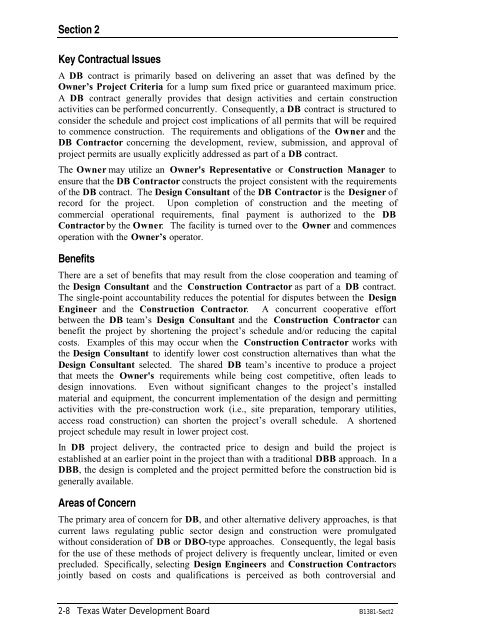Alternative Project Delivery - Texas Water Development Board
Alternative Project Delivery - Texas Water Development Board
Alternative Project Delivery - Texas Water Development Board
Create successful ePaper yourself
Turn your PDF publications into a flip-book with our unique Google optimized e-Paper software.
Section 2<br />
Key Contractual Issues<br />
A DB contract is primarily based on delivering an asset that was defined by the<br />
Owner’s <strong>Project</strong> Criteria for a lump sum fixed price or guaranteed maximum price.<br />
A DB contract generally provides that design activities and certain construction<br />
activities can be performed concurrently. Consequently, a DB contract is structured to<br />
consider the schedule and project cost implications of all permits that will be required<br />
to commence construction. The requirements and obligations of the Owner and the<br />
DB Contractor concerning the development, review, submission, and approval of<br />
project permits are usually explicitly addressed as part of a DB contract.<br />
The Owner may utilize an Owner's Representative or Construction Manager to<br />
ensure that the DB Contractor constructs the project consistent with the requirements<br />
of the DB contract. The Design Consultant of the DB Contractor is the Designer of<br />
record for the project. Upon completion of construction and the meeting of<br />
commercial operational requirements, final payment is authorized to the DB<br />
Contractor by the Owner. The facility is turned over to the Owner and commences<br />
operation with the Owner’s operator.<br />
Benefits<br />
There are a set of benefits that may result from the close cooperation and teaming of<br />
the Design Consultant and the Construction Contractor as part of a DB contract.<br />
The single-point accountability reduces the potential for disputes between the Design<br />
Engineer and the Construction Contractor. A concurrent cooperative effort<br />
between the DB team’s Design Consultant and the Construction Contractor can<br />
benefit the project by shortening the project’s schedule and/or reducing the capital<br />
costs. Examples of this may occur when the Construction Contractor works with<br />
the Design Consultant to identify lower cost construction alternatives than what the<br />
Design Consultant selected. The shared DB team’s incentive to produce a project<br />
that meets the Owner's requirements while being cost competitive, often leads to<br />
design innovations. Even without significant changes to the project’s installed<br />
material and equipment, the concurrent implementation of the design and permitting<br />
activities with the pre-construction work (i.e., site preparation, temporary utilities,<br />
access road construction) can shorten the project’s overall schedule. A shortened<br />
project schedule may result in lower project cost.<br />
In DB project delivery, the contracted price to design and build the project is<br />
established at an earlier point in the project than with a traditional DBB approach. In a<br />
DBB, the design is completed and the project permitted before the construction bid is<br />
generally available.<br />
Areas of Concern<br />
The primary area of concern for DB, and other alternative delivery approaches, is that<br />
current laws regulating public sector design and construction were promulgated<br />
without consideration of DB or DBO-type approaches. Consequently, the legal basis<br />
for the use of these methods of project delivery is frequently unclear, limited or even<br />
precluded. Specifically, selecting Design Engineers and Construction Contractors<br />
jointly based on costs and qualifications is perceived as both controversial and<br />
2-8 <strong>Texas</strong> <strong>Water</strong> <strong>Development</strong> <strong>Board</strong> B1381-Sect2
















